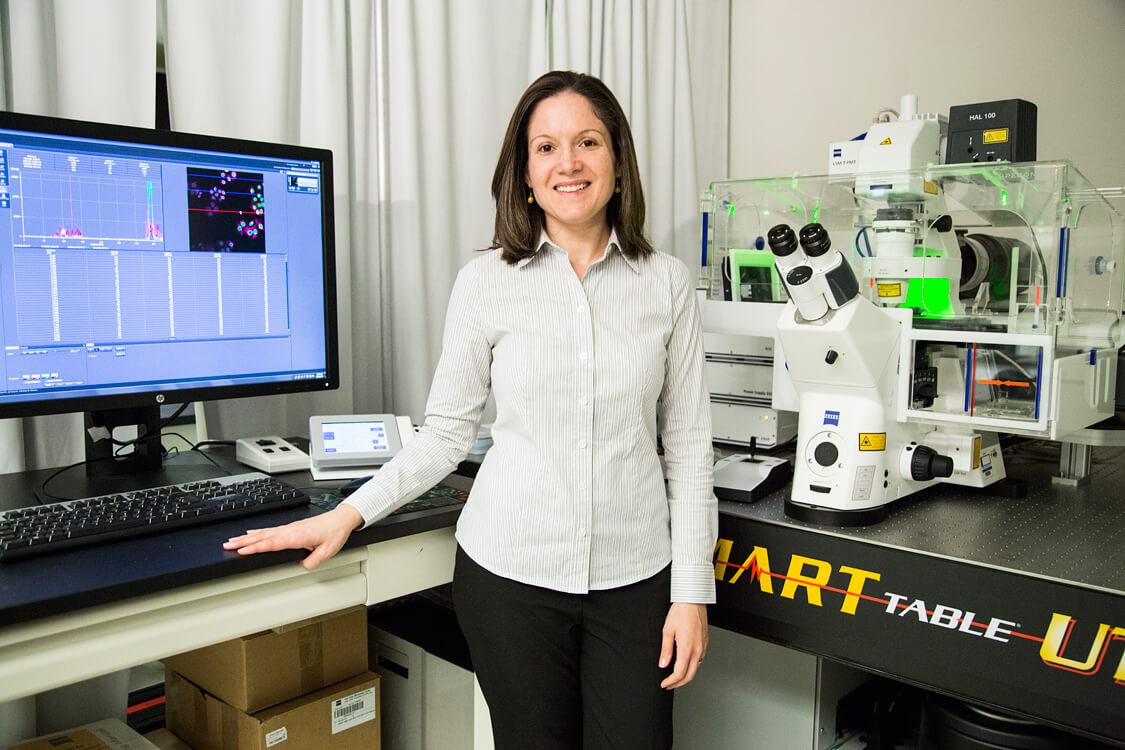Orange Alert
Skin cancer is the most common type of cancer, according to the American Cancer Society. In fact, the Skin Cancer Foundation estimates that one in five Americans will develop skin cancer in their lifetime. Even when we apply protective sunblock, how can we know the extent to which the sun’s rays affect us?
Enter a new type of wearable made from a smart material developed by Andrea Armani’s lab. It’s a patch that turns orange to let the wearer know he or she has had too much exposure to UV rays.
Some of the motivation for this innovation was personal, Armani explained. “My skin is hyper-sensitive. I burn very easily—I start to burn within minutes in some climates,” said Armani, holder of the Fluor Early Career Chair in Engineering at USC Viterbi. She wanted a way to check her own sun exposure, say, at the beach, without using a device like an Apple watch or a smartphone. While sensors existed on the market, they required batteries, electronics and couldn’t get wet.
Then, at a Health Engineering Technology (HTE) retreat, an oncologist mentioned to Armani that he was trying to monitor the amount of sun exposure his patients received after they had been diagnosed with skin cancer and treated. He wanted to be sure they followed his instructions and protocols, and wanted a way for the patients to check themselves.
So Armani turned to the graduate students in her lab to develop a smart material that would react with the UV rays emitted by the sun.
Michele Lee, a materials science Ph.D. candidate interested in smart materials, and Eda Gungor, a chemist and postdoctoral researcher in the Mork Family Department of Chemical Engineering and Materials Science, eagerly took up the challenge.
Lee used this as the basis for her thesis project. Over a period of about four years, she integrated UV-responsive molecules into nontoxic polymers. It was tricky, she said, because she wanted to put the UV-responsive molecule into the center of the spaghetti-like polymers to give greater control of the material.
Once they invented the material, it took another year to develop the sensor, a transparent, flexible, color-changing patch about a half-inch square, constructed of FDA-approved nontoxic polymers. By changing color, the patch notifies the wearer of his or her exposure to ultraviolet rays. When the patch turns orange, the user has reached the daily dose of vitamin D recommended by the World Health Organization. The material is now patented.
Because the flexible patch the Armani Research Lab developed is less than half a millimeter thick, it’s ideal for anyone who spends a lot of time in the sun. “It’s like a Band-Aid,” Armani said. “Wear it and throw it away.”
The patches can be stored for up to five weeks. More significantly, the sensors can be modified — the material’s reaction will actually adjust to applied sunblock. In addition, the sensors can be manufactured for individual users. For instance, the sensor has only one response unit that causes the color change. Thus, the concentrations of those responsive units can be increased so that the color will appear to change faster. These adjustments may be particularly relevant for people who have greater photosensitivity due to health conditions, antibiotics consumption or chemotherapy.
Armani says that beyond health care, there are many potential applications and markets for this smart material technology. One is for photosensitive pharmaceuticals, as some products are rendered ineffective by overexposure to heat and sunlight. The smart material could be placed on the inside of a prescription bottle, and based on the color of the sensor inside, the patient would know if the medicine has been exposed to too much heat or sun. It could also be employed and calibrated for food products to ensure that they aren’t spoiled by sun exposure.
Lee also envisions that these patches could be integrated with other technologies in the future. For example, if there were a broader color range, “you can use this in tandem with electronics, a more specific reading of exactly how much UV you are be exposed to,” she said. “Your phone would take a picture of the sensor’s color and that color would be matched electronically to number values that show the intensity of the exposure.”





